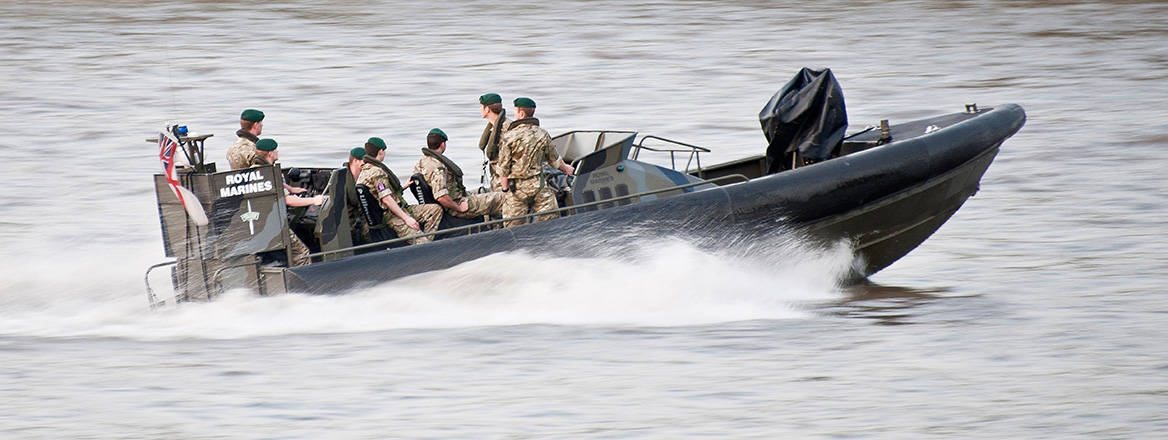Amphibious Futures: The Royal Marines in Contested New Operating Environments
This paper analyses the key adaptations that Western amphibious forces will need to make to contribute to deterrence and warfighting in the future operating environment.
In particular, the paper addresses how the force design of the UK’s Royal Marines will need to evolve for the marines to be able to contribute to the amphibious capabilities of an alliance or a coalition.
The paper argues that, rather than being a capability which is used to exploit sea control once a fleet has secured it, amphibious forces should represent a landward extension of the fleet. This is subtly different, as it involves closely integrating amphibious forces with two strictly naval functions: maritime strike; and efforts to secure sea control. Such a use of amphibious forces entails tactical specialisation, with a particular focus on closing a potential gap between bluewater navies and the joint force. However, as will be discussed, a tactical focus on enabling strikes need not limit the number of use cases for more specialised amphibious forces.
A major feature of the future operating environment is likely to be adversaries with enhanced anti-access capabilities and longer-ranged fires ashore. For allied and coalition amphibious forces, this means that disembarked forces will need to be distributed more widely, and the shipping that supports them will have to operate from greater distances. While this challenge will be especially acute in contexts involving near-peer opponents, the proliferation of anti-access capabilities makes it a likely challenge in several contexts in which UK and allied amphibious forces may be deployed.
This paper argues that adapting to this emerging operating environment will be best achieved through a concept of operations that subsumes amphibious power projection under the naval functions of strike and sea control. Distributed amphibious forces have a key operational role to play in tackling the challenge of enhanced anti-access capabilities through converging long-range fires capabilities. While this approach, epitomised by the US Marine Corps’ Expeditionary Advanced Base Operations framework, is typically treated as synonymous with sea denial, it in fact has wider applicability. Having a mix of dispersed long-ranged fires, both afloat and ashore, and small groups of raiding forces, can present serious dilemmas to large opposing ground forces.
Though the combination of raiding and fires is not an exclusively amphibious solution, forces capable of manoeuvring both at sea and on land can compound the challenge for an opponent. In many contexts, including the narrow archipelagic seas of Europe, using amphibious forces in this way would force an opponent to survey an extended littoral space that encompasses mainland areas, the maritime domain and offshore islands. This would considerably increase the opponent’s ISR burden.
There are a number of functions on the maritime side of the littoral to which amphibious forces can also contribute, among them the exercise of sea control in politically sensitive conditions. This paper argues that amphibious operations should therefore be subsumed under two naval missions – strike and sea control – rather than being treated as a separate function.
Within this rubric, the Royal Marines have the potential to act as an enabling force, both for strike-centric partners, and for both UK and allied naval forces. As a light raiding force, the marines can set the conditions for strike missions to be conducted on favourable terms. An emphasis on a lighter disembarked force should allow the maritime enablers upon which the commando force depends to evolve in ways that make them more multifunctional. Once a requirement to move heavy equipment is reduced, more emphasis can be placed on priorities such as the ability to carry sensors and strike munitions and achieving low observability. This can then enable tasks such as sea control, as well as archipelagic warfare on both sides of the littoral.
Shifting the emphasis of the Royal Marines towards the two priorities of strike and sea control implies tactical specialisation. But it does not necessarily imply a limitation of the operational and strategic roles that marines will play. Having a strike-centric concept of operations has demonstrable utility, both in contingencies in Europe and at expeditionary reach. It would involve narrowing the tactical roles and certifications of commandos, as well as a reduced emphasis on traditional light infantry functions. However, the size of the force and the changing operating environment mean that many of these functions are likely to be redundant in any case.
Emerging threats are making theatre entry for amphibious forces as it is presently conducted increasingly difficult and increasing the demand on the rest of the fleet and the wider joint force to provide protection to such forces where they do contribute. The risk facing amphibious forces, then, is that the value of amphibious insertion comes to be seen as being outweighed by its costs and risks. It is the argument of this paper that amphibious forces, including the Royal Marines, need not cede the littoral to shore-based anti-access/area denial capabilities. Such forces have the potential to add considerable value to allied deterrence. But to be able to do so in the future operating environment, they must integrate more closely with fleets, both in conceptual terms and in force design.
WRITTEN BY
Dr Sidharth Kaushal
Senior Research Fellow, Sea Power
Military Sciences
Brigadier Mark Totten
Brigadier Mark Totten is Deputy Director of the Defence Equipment and Support (DE&S) Weapons Operating Centre.
- Jim McLeanMedia Relations Manager+44 (0)7917 373 069JimMc@rusi.org


